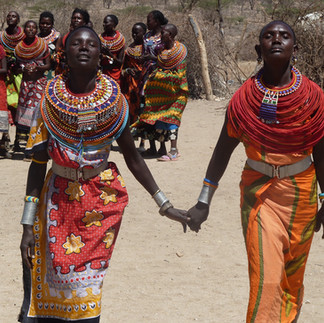Africa’s Booming Creative Economy: From Nollywood to Afrobeats
- The Trade Adviser

- Aug 25, 2024
- 5 min read
Africa's creative economy is experiencing an unprecedented boom, driven by a dynamic blend of traditional art forms and modern media. From Nollywood, Nigeria’s thriving film industry, to the global rise of Afrobeats music, Africa's creative industries are making a significant impact on the global stage.
This surge in creativity is not just about entertainment; it’s fueling economic growth, creating jobs, and reshaping perceptions of the continent. This article explores the rise of Africa’s creative economy, the factors driving its growth, and the challenges and opportunities it presents.
1. Nollywood: The Powerhouse of African Cinema
Nollywood, Nigeria's film industry, is the second-largest film producer in the world, only behind India’s Bollywood. Producing over 2,500 films annually, Nollywood has become a significant cultural and economic force, not just in Africa but globally. The industry is estimated to generate over $600 million annually and employs hundreds of thousands of people, making it a critical sector for Nigeria’s economy.
Global Influence and Reach: Nollywood films are known for their unique storytelling, often reflecting the complexities of African life, culture, and traditions. These films resonate not only with African audiences but also with the African diaspora and beyond. Platforms like Netflix and Amazon Prime have recognized Nollywood’s potential, leading to increased international distribution and visibility. In 2020, Netflix launched a dedicated category for Nollywood films, further boosting the industry’s global reach.
Challenges and Innovation: Despite its success, Nollywood faces several challenges, including piracy, limited funding, and infrastructural constraints. However, the industry is rapidly innovating to overcome these hurdles. For instance, filmmakers are increasingly turning to crowdfunding and international co-productions to finance their projects. Additionally, advancements in digital technology are enabling more efficient production and distribution processes, allowing Nollywood to reach even wider audiences.
2. Afrobeats: The Soundtrack of a Generation
Afrobeats, a genre that blends African rhythms with Western pop, hip-hop, and electronic music, has become a global phenomenon. Originating in Nigeria and Ghana, Afrobeats has captivated listeners worldwide, earning top spots on international music charts and influencing mainstream music across the globe.
Global Success Stories: Artists like Burna Boy, Wizkid, and Davido have been at the forefront of the Afrobeats movement, achieving international success and collaborating with global superstars like Beyoncé, Drake, and Chris Brown. Burna Boy’s album "Twice As Tall" won a Grammy Award in 2021, a milestone that marked a significant moment for African music on the global stage.
Economic Impact: The rise of Afrobeats has not only elevated Africa’s cultural status but also contributed significantly to its economy. The Nigerian music industry alone is worth over $73 million and is expected to grow at a compound annual growth rate (CAGR) of 13.4% by 2023, according to PwC. This growth is driven by the increasing popularity of streaming services, live performances, and international tours.
3. Fashion: Africa’s Bold New Aesthetic
Africa’s fashion industry is another pillar of its creative economy, combining traditional craftsmanship with contemporary design. African fashion designers are gaining international recognition for their innovative use of color, texture, and patterns, drawing inspiration from the continent’s rich cultural heritage.
Notable Designers and Brands: Designers like Imane Ayissi from Cameroon, who became the first sub-Saharan African designer to showcase at Paris Haute Couture Week, and South Africa’s Thebe Magugu, who won the prestigious LVMH Prize in 2019, are leading the charge. African fashion brands are increasingly featured in global fashion weeks, and their designs are worn by celebrities and influencers worldwide.
Sustainability and Ethical Fashion: Sustainability is a growing focus within Africa’s fashion industry, with many designers and brands committed to ethical production practices. The use of locally sourced materials, traditional techniques, and support for artisan communities are central to this movement.
Initiatives like the Ethical Fashion Initiative, which connects African artisans with global fashion brands, are helping to promote sustainable practices and provide economic opportunities for local communities.
4. Digital Media and Content Creation: A New Frontier
The digital revolution has opened up new avenues for African content creators, from YouTube vloggers and Instagram influencers to podcasters and bloggers. The proliferation of affordable smartphones and internet access has democratized content creation, allowing young Africans to share their stories with the world.
Social Media Influencers: Social media platforms have become powerful tools for African creatives to build personal brands and reach global audiences. Influencers like South Africa’s Mihlali Ndamase and Kenya’s Sharon Mundia have amassed large followings, collaborating with international brands and generating significant income through sponsored content.
Streaming and Digital Platforms: Streaming platforms like Showmax, IROKOtv, and Spotify are also playing a crucial role in distributing African content to global audiences. These platforms provide a space for African filmmakers, musicians, and content creators to showcase their work, often bypassing traditional distribution channels. For example, the South African series "Blood & Water" became a global hit on Netflix, highlighting the potential of African content to resonate with international audiences.
5. Challenges Facing Africa’s Creative Economy
Despite the rapid growth of Africa’s creative industries, several challenges remain. These include limited access to funding, inadequate infrastructure, and the need for stronger intellectual property protections.
Funding and Investment: Access to capital is a significant barrier for many African creatives, particularly those working in the early stages of their careers. While there is growing interest from international investors, more needs to be done to provide financing options that cater specifically to the needs of the creative sector. Public and private partnerships, as well as crowdfunding platforms, can play a vital role in filling this gap.
Infrastructure and Distribution: Infrastructure limitations, including unreliable electricity and internet access, can hinder content creation and distribution. Improving digital infrastructure across the continent is essential to unlocking the full potential of Africa’s creative economy. Additionally, building stronger distribution networks, both within Africa and internationally, will help African creatives reach wider audiences.
Intellectual Property Protection: Piracy remains a significant issue in Africa, particularly in the film and music industries. Strengthening intellectual property laws and enforcement mechanisms is crucial to protecting the rights of African creatives and ensuring that they receive fair compensation for their work. Initiatives like the African Continental Free Trade Area (AfCFTA) could play a role in harmonizing IP protections across the continent.
6. The Future of Africa’s Creative Economy
The future of Africa’s creative economy is bright, with tremendous potential for growth and global influence. As more African creatives gain international recognition, the continent’s cultural and economic contributions will continue to expand. However, realizing this potential will require addressing the challenges facing the industry, including funding, infrastructure, and IP protection.
Continued Global Collaboration: Collaborations between African creatives and international brands, artists, and platforms will be key to driving growth and expanding global reach. These partnerships can provide African creatives with the resources and exposure needed to thrive in the global market while offering fresh perspectives and innovation to global audiences.
Empowering the Next Generation: Investing in education and skills development for young Africans interested in creative careers is essential for sustaining the growth of the creative economy. Initiatives that provide training, mentorship, and access to resources will help nurture the next generation of African creatives and ensure that the continent remains at the forefront of global cultural production.
Conclusion
Africa’s creative economy is experiencing a renaissance, with Nollywood, Afrobeats, fashion, and digital content creation leading the charge. These industries are not only contributing to economic growth but also reshaping global perceptions of Africa as a vibrant, innovative, and culturally rich continent.
While challenges remain, the potential for Africa’s creative economy to become a dominant force on the global stage is undeniable. With continued investment, innovation, and collaboration, Africa’s creative industries will continue to thrive, offering new opportunities for economic empowerment and cultural expression.









